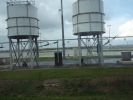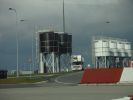

In order to generate lift, the wing surfaces must be smooth to allow undisturbed airflow around them. When there's enough liquid water in the air and when the temperatures are below freezing point, ice is likely to form on the aircraft fuselage, wings, engines, and other surfaces of the aircraft. The ice must be removed before the aircraft can take off. The process of removing the ice is called deicing.
Deicing is usually done by spraying the airliners with a deicing fluid. The fluid will lower the melting temperature of the ice and the ice then melts even when its temperature is still below zero. The fluid is stored on airports in special tanks, which you can see on the first two pictures.
When an aircraft needs deicing, it taxies to a predetermined area where the deice cars are waiting for it. The cars have a tank for the deicing fluid and a movable platform with hoses and sprayers. The driver will move the platform so the sprayers can spray the deicing fluid on all of the aircraft surfaces that need deicing. You can see the deice cars on the next set of pictures. Unfortunately, since it was not that cold during the tour, we didn't see any deicing in action.
Often an anti-icing fluid is applied onto the aircraft after it's deiced; this fluid will prevent ice on forming on the surfaces for a while even after the aircraft starts moving and becomes airborne.
Then all the equipment is moved away from the aircraft and once the pilots receive clearance to start taxiing, the plane starts moving to the assigned runway.
Most airliners also have an automated anti-icing system that can be used while airborne. This system is usually limited to wing and horizontal stabilizer leading edges and the engine inlets, because the ice is most likely to form on these areas of an airborne aircraft. The anti-icing system can use hot air routed from the engines (called bleed air) to warm the affected areas above the freezing point, electrial heating, or a similar mechanism of melting the ice. But even aircraft equipped with this system may need on-the-ground deicing, because the anti-icing system is only usable when the aircraft is fully powered and/or moving.
Copyright notice: Text and images copyright by Michal Řeháček.